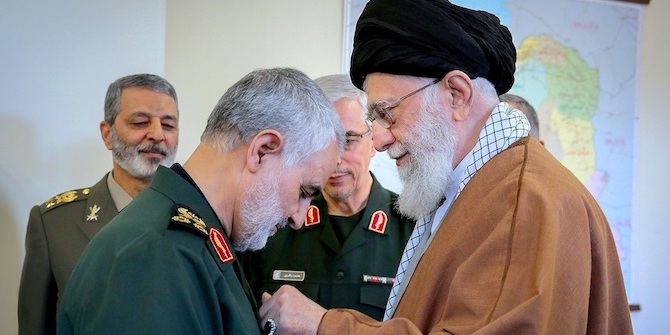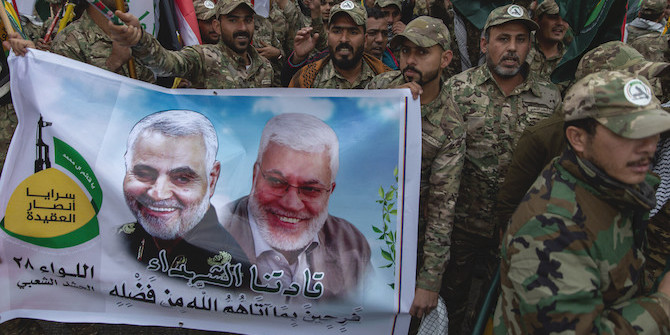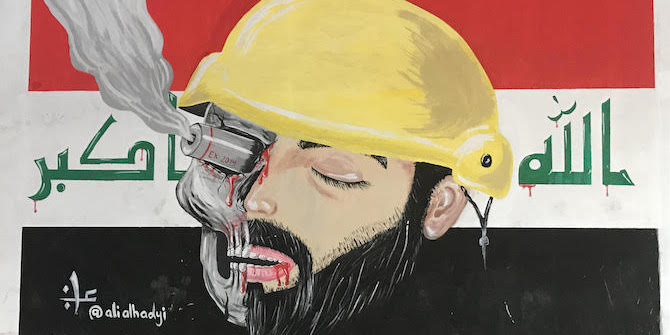by Rufat Ahmedzade

General Qassem Soleimani’s demise in an American drone attack on the orders of US President Donald Trump is going to have a major impact on Iran’s projection of power in the region. General Soleimani was instrumental in Tehran’s interventionist policies in the Middle East and controlled the Syria and Iraq portfolios of Iran’s foreign policy. This makes it hard to replace Soleimani with an equally strong character, able to continue Tehran’s strong ties with its powerful militias in the region; ties forged under Soleimani mostly due to his personal relationships and capabilities. Newly appointed Iranian Revolutionary Guard Corps (IRGC) Quds Force commander Esmail Ghaani seems to lack Soleimani’s charisma and he will have to prove himself at his new job.
What is certain is that the Islamic Republic leadership has suffered a major setback in its regional policies. Supreme Leader Ayatollah Khamenei’s generals believed that they had already established ‘deterrence’ against the US via proxy groups, but this has backfired with Soleimani’s assassination. General Soleimani was the driving force in Iran’s power projection policy and architect of the regional structures that have sustained the Islamic Republic’s strategic politico-military upper hand from Tehran to Beirut.
The entire Iranian leadership seems to have miscalculated President Trump’s willingness to act after testing his response to various Iranian plots such as the mysterious strikes on Saudi Aramco oil facilities, attacks on oil tankers in the Persian Gulf, the shooting of an American unmanned drone over the Gulf, and several rocket attacks on various US military installations inside Iraq. IRGC commanders and Khamenei believed that Trump’s warnings were nothing but bluster. Taking into account his election campaign promise to put an end to ‘endless wars’ in the Middle East, the Iranian leadership thought the Trump administration would be unwilling to escalate tensions with Iran.
This changed after the rocket attack on a US base in Iraq on 27 December, when an American contractor was killed and several others were injured. The launch of US airstrikes on Iraqi and Syrian military installations of the primary suspect, Kataib Hezbollah, was the first kind of attack by the US against Shi’a forces in Iraq after more than a decade. Predictably the Shi’a militias, the Hashd al Sha’abi (PMU), responded to the US strike with prominent militia leaders including Abu Mahdi al-Muhandis, Qais al-Khazali and Hadi al-Ameri and their supporters storming the US embassy in Baghdad. This bore Soleimani’s fingerprints, as a decision like that could not have been taken without his knowledge.
Iran’s leaders do seem, however, to have weighed their retaliation to Soleimani’s killing more carefully. Though they were not deterred by President Trump’s tweeted threats that ‘if Iran hits US bases’ they would really suffer, it looks as if the Iranians deliberately avoided inflicting heavy casualties when they fired a barrage of missiles at US bases in Iraq on 8 January. That night, Iran and the US exchanged de-escalatory messages via the Swiss ambassador, the Financial Times reported. Despite his earlier rhetoric President Trump pulled back from a military response to the attack, declaring instead that Washington would focus on punishing economic sanctions.
The strikes – directed from Iranian territory – proved that the Islamic Republic has the capability to hit American military installations in Iraq. For the first time, Tehran took responsibility for its military action and did not use a proxy force to attack US troops. This was also a matter of prestige for Supreme Leader Khamenei and the regime. Iranian officials considered the retaliatory strikes to be ‘proportionate measures in self-defence’, according to Foreign Minister Mohammad Javad Zarif. ‘We do not seek escalation or war, but will defend ourselves against any aggression’, he tweeted.
Will Iran’s Regional Influence Dwindle after Soleimani’s Death?
It will be extremely difficult for the Iranian regime to coordinate its regional proxies following the deaths of Soleimani and al-Muhandis. By the end of last year, Iran’s hegemony was facing serious challenges in Iraq and Lebanon, as popular rage against its control and interference spilt into the streets in Baghdad and Beirut. The burning of Iran’s diplomatic missions, Khamenei’s posters, and Iranian flags were clear signs of a growing backlash against Tehran’s hegemony. By early December 2019 more than 400 Iraqi protesters had been killed in a violent crackdown by militias loyal to Tehran and the Iraqi security forces, according to the UN envoy to Iraq. Meanwhile in Beirut, Hezbollah supporters tried to quell public demonstrations in the city’s streets.
Since 25 January this year violence has again intensified in Iraq, as the authorities and security forces seek to stamp out anti-government protests. Iran may have hoped that Muqtada al-Sadr’s switch in support from the anti-government demonstrations to the anti-US protests would help to quell the unrest, but there is no sign of protesters’ anger abating.
While the Iranian regime considers its political grip in the countries of the region as a protective shield against possible domestic upheaval, protests in Iran started in the autumn against the gasoline price hikes and turned to politics, highlighting the extreme challenges the Islamic Republic is facing. The domestic and regional legitimacy of the ruling system is vulnerable, so crushing protests with violent force was aimed at aborting any unpredictable scenarios in Iran. More than 1,500 protestors were shot and killed, according to Reuters, with the command to crush the protests coming from the Supreme Leader himself.
The Iranian regime must have felt bolstered by the outpouring of domestic public support following Soleimani’s killing. Hundreds of thousands of people were out on the streets mourning the general, rather than protesting at price hikes. This solidarity was soon fractured though, when the Revolutionary Guards shot down a Ukrainian passenger plane in error, killing all 176 people on board. The attempts to cover up the catastrophic mistake only made the public reaction worse. Protesters, many of them university students, were outspoken in their contempt for the authorities, calling on the Supreme Leader to step down.
Trump’s maximum pressure policy is already creating problems for Tehran as financial resources are hit by strong economic sanctions. In the long run, it is going to be extremely difficult for the regime to sustain its proxies financially, and after the death of General Soleimani, who was in charge of handling pro-Iranian elements, the future of Iran’s hegemonic policies is uncertain.






